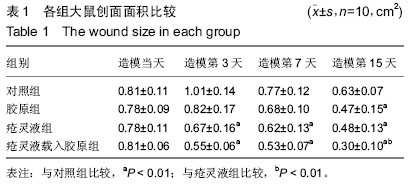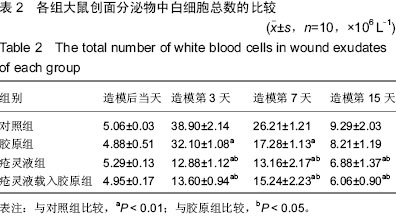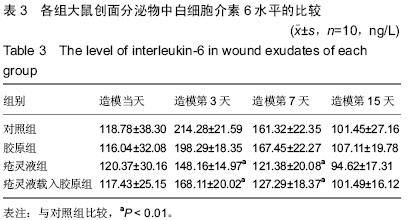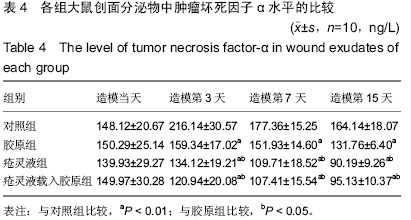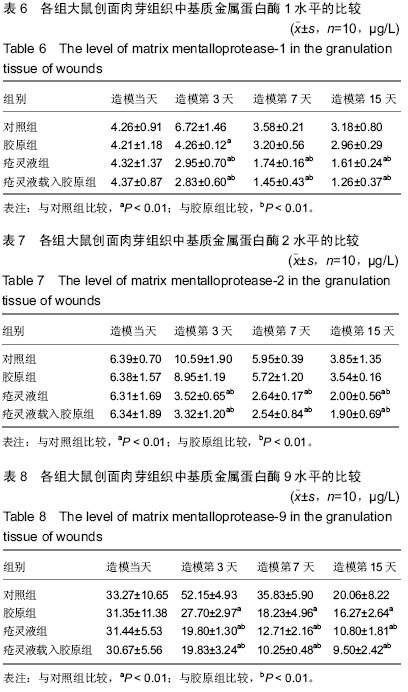| [1] Mustoe TA,O'Shaughnessy K,Kloeters O.Chronic wound pathogenesis and current treatment strategies: a unifying hypothesis.J Plast Reconstr Surg.2006;117:35-41.
[2] Broughton G,Janis JE,Attinger CE.The basic science of wound healing. Plastic Reconstr Surg.2006;117(7):12-34.
[3] Gottrup F.A specialized wound-healing center concept: importance of a multidisciplinary department structure and surgical treatment facilities in the treatment of chronic wounds. Am J Surg.2004;187(5A):38-43.
[4] Guo S, Dipietro LA. Factors Affecting Wound Healing. J Dent Res.2010;89(3):219-229.
[5] Moore K,Huddleston E,Stacey MC,et al.Venous leg ulcers- the search for a prognostic indicator.Int Wound J.2007; 4: 163-172.
[6] 石冰,谭家祺,陈绍宗.慢性创面的病理生理以及治疗[J].组织工程与重建外科杂志, 2006,2(1):58-60.
[7] 尹松林,简华刚.慢性创面的特点与负压创面治疗技术[J].重庆医学,2012,41(8):813-815.
[8] 任晓梅,姚昶,朱永康,等.疮灵液胶原对创面愈合的促进作用[J].山东医药,2013 53(43):27-29.
[9] Martin JM,Zenilman JM,Lazarus GS.Molecular microbiology: new dimensions for cutaneous biology and wound healing.J Invest Dermatol.2010;130:38-48.
[10] Vaalamo M,Mattila L,Johansson N,et al.Distinct populations ofstromal cells express collagenase- 3 (MMP- 13) and collagenase- 1 (MMP- 1) in chronic ulcers but not in normally healing wounds.J Invest Dermatol.1997;109(1):96-101.
[11] Wysocki AB,Staiano-Coico L,Grinnell F.Wound Fluid from chronic Leg Ulcers Contains Elevated Levels of Metallopro- teinases MMP-2 and MMP-9 .J Invest Dermatol.1993;101: 64-68.
[12] 张凯,朱家源,唐冰,等.慢性创面的病原菌调查分析[J].中华医院感染学杂志, 2012,22(11):2455-2457.
[13] 常菲,杨长伟,路卫.难愈创面的发生机制和治疗进展[J].第二军医大学学报, 2007,28(11):1259-1261.
[14] Lateef H,Stevens MJ,Varani J.All-trans-retinoic acid suppresses matrix metalloproteinase activity and increases collagen synthe- sis in diabetic human skin in organ culture. Am J Pathol.2004;165(1):167-174.
[15] 石冰,李望舟,李学拥,等.封闭负压引流治疗中人慢性创面肿瘤坏死因子水平的变化[J].中国临床康复,2005,9(42):92-94.
[16] 缪雪华,周勇,任伟业,等.胶原海绵促进肉芽生长与创面愈合实验研究[J].中国当代医药, 2012,19(10):26-30.
[17] Takayama M,Kuramoto Y,Okuyama R,et al.The exudate of pressure ulcers contains a substantial amount of vascular endothelial growth factor. Tohoku J Exp Med.2010;221(4): 315-319.
[18] Graham ID,Harrison MB,Nelson EA,et al.Prevalence of lower-limb ulceration: a systematic review of prevalence studies.Adv Skin Wound Care.2003;16:305-316.
[19] Branski LK,Gauglitz GG,Herndon DN,et al.A review of gene and stem cell therapy in cutaneous wound healing.Burns. 2009;35:171-180.
[20] Lau K,Paus R,Tiede S,et al.Exploring the role of stem cells in cutaneous wound healing.Exp Dermatol.2009;18:921-933.
[21] 宋金斌,王朝晖,任菊琴,等.疮灵液的研制和临床应用[J].时珍国药研究,1996,7(5):318 -320.
[22] 张爱华,陆茵,许慧琪,等.疮灵液的药理研究[J].江苏药学与临床研究,1997,1(4):14-18.
[23] 杨能华.疮灵液治疗缺血性溃疡38例[J].南京中医药大学学报, 1997,13(5):310 -311.
[24] 王朝晖,任菊琴,宋金斌,等.疮灵液用于溃疡的临床及实验研究[J].山西护理杂志,1997, 11(5):200-203.
[25] 张宇轩,姚昶,朱永康,等.疮灵液载入胶原对血管新生影响的实验研究[J].南京中医药大学学报,2013,29(3):251-254.
[26] Assadian O,Assadian A,Stadler M,et al.Bacterial growth kinetic without the influence of the immune system using vacuum-assisted closure dressing with and without negative pressure in an in viro wound model.Int Wound J.2010;7(4): 283-289.
[27] Thomsen TR,Aasholm MS,Rudkjøbing VB,et al.The bacteriology of chronic venous leg ulcer examined by culture-independent molecular methods. Wound Repair Regen.2010;18:38-49.
[28] 张晶,姚昶,尹恒,等.生肌玉红膏促进下肢慢性创面愈合257例随机对照多中心临床研究[J].中医杂志,2013,54(1):35-38.
|
